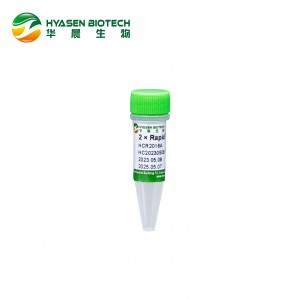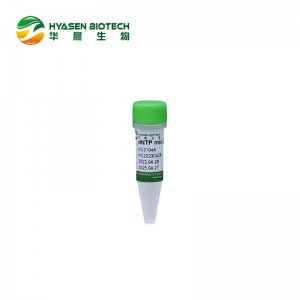.jpg)
Superstart qPCR Premix plus-UNG
Cat No: HCB5071E
Superstart qPCR Premix plus-UNG is a specialized reagent designed for Real Time PCR qualitative and quantitative reactions using probe-based detection, developed specifically for lyophilization processes. It contains a novel hot-start enzyme Hotstart Taq plus (DG), which has its Taq enzyme activity sealed at room temperature, effectively inhibiting non-specific amplification caused by primer non-specific annealing or primer dimer formation under low temperature conditions, thus improving the specificity of the amplification reaction. This reagent uses an optimized qPCR specific buffer and UNG/dUTP anti-contamination system to achieve rapid hot-starting, greatly improving the efficiency and sensitivity of qPCR reactions. It can obtain good standard curves in a wide range of quantitation areas and accurately perform quantitation, effectively preventing false positive amplification caused by residual PCR products or aerosol contamination. This reagent is compatible with most fluorescent quantitative PCR instruments from manufacturers such as Applied Biosystems, Eppendorf, Bio- Rad and Roche etc., and exhibits good stability in lyophilized form.
Reagent composition
1. 5×HotstartPremix plus-UNG (Mg2+ free) (DG)
2. 250 mM MgCl2
3. 4×lyoprotectant (optional)
Storage Conditions
Long-term storage at -20℃; can be stored at 4℃ for up to 3 months. Mix well before use and avoid repeated freezing and thawing.
Cycling Protocol
|
Procedure |
Temp. |
Time |
Cycle |
|
Digestion |
50℃ |
2 min |
1 |
|
Polymerase activation |
95℃ |
1~5 min |
1 |
|
Denature |
95℃ |
10~20 s |
40-50 |
|
Annealing and Extension |
56~64℃ |
20~60 s |
40-50 |
qPCR Liquid Reaction System Preparation
|
Composition |
25µL Volume |
50µL Volume |
Final Concentration |
|
5×HotstartPremix plus-UNG (Mg2+ free) (DG) |
5µL |
10µL |
1× |
|
250mM MgCl2 |
0.45µL |
0.9µL |
4.5 mM |
|
4×lyoprotectant 1 |
6.25µL |
12.5µL |
1× |
|
25×Primer-Probe Mix 2 |
1µL |
2µL |
1× |
|
Template DNA3 |
—— |
—— |
—— |
|
ddH2O |
To 25µL |
To 50µL |
—— |
1. A final concentration of 0.2μM for primers usually yields good results; when reaction performance is poor, adjust primer concentration within the range of 0.2-1μM as needed. Probe concentration is typically optimized within the range of 0.1-0.3μM through gradient experiments to find optimal combinations.
2. The copy number of target genes contained in different types of templates varies; if necessary,gradient dilution can be performed to determine the optimal template addition amount.
3. This system can be lyophilized; when customers use this system without freezing-drying requirements, 4×lyoprotectant can be selectively added;if there are freeze-dried products required,during liquid reagents stage product performance validation, it must add 4×lyoprotectant to ensure consistency with the lyophilized system components and effects.
When the system is used for freeze-drying, prepare the system as following:
|
Composition |
25µL Reaction System |
|
5 ×HotstartPremix plus-UNG (Mg2+ free) (DG) |
5µL |
|
250mM MgCl2 |
0.45µL |
|
4×lyoprotectant |
6.25µL |
|
25×Primer-Probe Mix |
1µL |
|
ddH2O |
To 18~20µL |
* If other systems for freeze-drying is needed, please consult separately.
Lyophilization Process
|
Procedure |
Temp. |
Time |
Condition |
Pressure |
|
Pre-freezing |
4℃ |
30 min |
Hold |
1 atm |
|
-50℃ |
60 min |
Cooling |
||
|
-50℃ |
180 min |
Hold |
||
|
Primary Drying |
-30℃ |
60 min |
Heating |
Ultimate Vacuum |
|
-30℃ |
70 min |
Hold |
||
|
Secondary Drying |
25℃ |
60 min |
Heating |
Ultimate Vacuum |
|
25℃ |
300 min |
Hold |
2. The above lyophilization process is for reference only. Different product types and different freeze-dryers have different parameters, so adjustments can be made according to actual conditions during use.
3. Different lyophilization processes may be suitable for different batch sizes of lyophilized products, so sufficient testing validation must be performed when used for large-scale production.
Instruction for using lyophilized powder
1. Briefly centrifuge the lyophilized powder;
2. Add nucleic acid template to the lyophilized powder and add water up to 25µL;
3. Mix well by centrifugation and run on machine.
Quality Control:
1. Functional testing: sensitivity, specificity, reproducibility of qPCR.
2. No exogenous nuclease activity, no exogenous endo/exonuclease contamination.
Technical Information:
1. Superstart qPCR Premix plus-UNG uses a novel hot-start enzyme that enables rapid hot-starting within 1~5 minutes; through special buffer formulation it is suitable for multiplex fluorescent quantitative PCR reactions.
2. It has higher specificity which significantly improves the sensitivity of fluorescence quantitative PCR limit detection,making amplification curves normalization, fluorescence value obtain obvious improvement at low concentration templates, suitable as high sensitivity fluorescence quantitative PCR detection reagents.
3. For primers with lower annealing temperature or longer than 200bp fragments, 3-step method is recommended.
4. The utilization efficiency of dUTP and sensitivity to UNG enzyme differ for different target genes, thus if using UNG system leads to a decrease in detection sensitivity, the reaction system should be adjusted and optimized. If technical support is required please contact our company.
5. Use dedicated areas and pipettes before and after amplification, wear gloves during operation and replace them frequently; do not open the reaction tube after PCR completion to minimize contamination of samples by PCR products.














